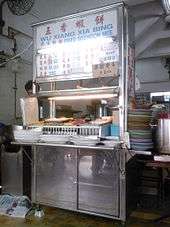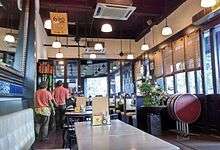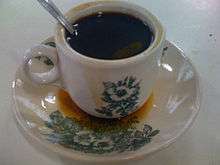Kopi tiam
A kopitiam or kopi tiam is a traditional coffee shop mostly found in Indonesia, Malaysia, Singapore, Brunei and Southern Thailand patronised for meals and beverages. The word kopi is an Indonesian and Malay term for coffee and tiam is the Hokkien/Hakka term for shop (店). Menus typically feature simple offerings: a variety of foods based on egg, toast, kaya, plus coffee, tea, Horlicks and Milo.

Malaysia

In Malaysia, as in Singapore, kopitiams are found almost everywhere. However, there are a few differences. In Malaysia:
- the term kopitiam in Malaysia is usually referred specifically to Malaysian Chinese coffee shops;
- food in a kopitiam is usually exclusively Malaysian Chinese cuisine;
- food courts and hawker centres are usually not referred to as kopitiams.
Recently a new breed of "modern" kopitiams have sprung up. The popularity of the old-fashioned outlets along with society's obsession with nostalgia and increasing affluence has led to the revival of these pseudo-kopitiams. The new kopitiams are fast-food outlets which are reminiscent of the old kopitiams in terms of decor, but are usually built in a more modern, hygienic setting such as a shopping mall rather than in the traditional shophouse, catering mainly for young adults.
To offer the true kopitiam experience, modern kopitiams mostly offer authentic local coffee brews, charcoal grilled toast served with butter and kaya (a local version of jam made from coconut milk and eggs) and soft-boiled eggs. Some have extended menus where local breakfast, lunch and dinner meals are served. To tap into the sizeable Muslim market, these kopitiams usually serve food that is halal (permissible for consumption by Muslims) unlike the traditional shophouse kopitiams.
Today there are no less than 100 brand names of modern kopitiams operating in various parts of Malaysia.
Kopitiams in Ipoh oldtown district serve Ipoh white coffee. The coffee beans are roasted with palm-oil margarine and with less sugar, resulting in a brew that is lighter in colour than normal coffee beans that uses sugar – hence the name 'white coffee'.
Singapore
Kopi tiams in Singapore are commonly found in almost all residential areas as well as some industrial and business districts in the country, numbering about 2,000 in total.[1] Although most are an aggregate of small stalls or shops, some may be more reminiscent of food courts, although each stall has similar appearance and the same style of signage. In a typical kopi tiam, the drinks stall is usually run by the owner who sells coffee, tea, soft drinks, and other beverages as well as breakfast items like kaya toast, soft-boiled eggs and snacks. The other stalls are leased by the owner to independent stallholders who prepare a variety of food dishes, often featuring the cuisine of Singapore. Traditional dishes from different ethnicities are usually available at kopitiams so that people from different ethnic backgrounds and having different dietary habits could dine in a common place and even at a common table.[2]
Kopitiam is also the name of a food court chain in Singapore.[3]
Some of the popular kopi tiams in Singapore include Kim San Leng, Killiney & Tong Ah Eating House or Ya Kun Kaya Toast
Some of the more common foods that can be seen in kopi tiams, besides the ever-popular eggs and toast, consist of char kway tiao (fried flat rice noodles (hor fun), sometimes cooked with eggs and cockles), Hokkien mee (yellow wheat noodles served with various seafood as well as egg) and, possibly the most common, nasi lemak, or coconut rice (a Malay dish of coconut-flavoured rice, served with sambal chilli paste, egg, and fried anchovies).

At kopi tiams (Chinese: 咖啡店; pinyin: kā fēi diàn; lit.: 'coffee shop'), coffee and tea are usually ordered using a specific vernacular featuring terms from different languages. Kopi (coffee) was created when Singapore started its development and had to cater to the needs of the European population - specifically their love for coffee.[4] "Kopi" (coffee) and "teh" (tea) can be tailored to suit the drinker's taste by using the following suffixes when ordering:
- "Peng" (Chinese: 冰; pinyin: bīng; Pe̍h-ōe-jī: peng; lit.: 'ice'; /pe̞ŋ/): with ice
- "Si" or "C" : with evaporated milk (Hainanese dialect) (Chinese: 鮮; pinyin: xiān; lit.: 'fresh')
- "Siew dai": less sugar (Hockchew/Fuzhou dialect) (Chinese: 少甜; pinyin: shǎo tián; lit.: 'less sweetness')
- "Ga Dai": more sugar/milk (Chinese: 加甜; pinyin: jiā tián; lit.: 'to increase sweetness')
- "O": no milk, sugar only (Chinese: 烏; pinyin: wū; lit.: 'to dye black')
- "Kosong" ("Nothing"): no sugar
- "kao": extra thick (Chinese: 厚; pinyin: hòu; lit.: 'thick')
- "Poh": extra thin (Chinese: 薄; pinyin: báo; lit.: 'thin')
- "Di Loh": straight no water added (Chinese: 直落; pinyin: zhí luò; lit.: 'directly into')
These are typically chained together to customize a drink order: a "kopi si kosong" will result in a coffee with evaporated milk and no sugar.
"Coffee shop talk"
"Coffee shop talk" is a phrase used to describe gossip because it is often a familiar sight at kopi tiams where a group of workers or senior citizens would linger over cups of coffee and exchange news and comments on various topics including national politics, office politics, TV dramas, sports and food.[5]
Example of typical kopitiam beverage terms
- Kopi o = hot black coffee (with sugar)
- Kopi o peng = iced black coffee (with sugar)
- Kopi o kosong = hot black coffee (unsweetened)
- Kopi o peng kosong = iced black coffee (unsweetened)
- Kopi = Coffee with condensed milk
- Kopi peng = iced coffee with condensed milk
- Kopi si = hot coffee with evaporated milk, with sugar
- Kopi si kosong = hot coffee with evaporated milk
- Kopi si peng = iced coffee with evaporated milk, with sugar
- Kopi sterng = iced coffee extra smooth.
- Teh o = hot tea (without milk, sweetened)
- Teh o peng = iced tea (without milk, sweetened)
- Teh o kosong = hot tea (without milk, unsweetened)
- Teh o kosong peng = iced tea (without milk, unsweetened)
- Teh = Tea with condensed milk (Chinese: 茶; pinyin: chá; lit.: 'tea')
- Teh tarik = Tea with condensed milk that is pulled (poured from a height) multiple times
- Teh peng = iced milk tea (sweetened)
- Teh si = hot tea with evaporated milk (sweetened)
- Teh si kosong = hot tea with evaporated milk (unsweetened)
- Teh si peng = iced tea with evaporated milk (sweetened)
- Tiao hee or tiao her = Chinese tea (Chinese: 釣魚; pinyin: diào yú; lit.: 'to angle fish')
- Tat kiu = Milo (Chinese: 踢球; pinyin: tī qiú; lit.: 'to kick ball')
- Cham = mixed of coffee and tea (sweetened) (Chinese: 參; pinyin: cān; lit.: 'to join')
- Cham peng = iced version of Cham (sweetened)
- Yin yang/Yuan yang = same as Cham (Chinese: 鴛鴦; pinyin: yuān yāng; lit.: 'male mandarin duck female mandarin duck')
- Michael Jackson = mixture of soy milk and grass jelly (black and white)
- Tai Ga Hao = Horlicks (means 'Hello everyone')[6] (Chinese: 大家好; pinyin: dà jiā hǎo; lit.: 'big family good')
Explanation of kopitiam terms
- Kopi = Malay for coffee
- O/oh = Hokkien for black (coffee) / without milk (tea)
- Peng = Hokkien for iced
- Kosong = Malay for "zero", meaning without sugar and condensed milk
- C/si = with evaporated milk
- Teh = tea
- Tiao hee or tiao her = Hokkien for 'fishing' Reference to dipping up and down of tea bag.
- Tart kiu = Hokkien for 'kicking a ball', as retro Milo tins often feature a soccer player kicking a ball on their labels.
- Siew tai = Foo chow (Hock Chew) or Cantonese for 'min tim' or 'less sweet/base', i.e. less sugar or sweet condensed milk (added to the bottom of the cup).
- Ka tai = Foo chow (Hock Chew) for 'add sweet' or Cantonese for 'ga tim' or 'add base' i.e. a sweeter beverage, with more sugar or condensed milk added.
- Pua Sio = Hokkien - Means half hot - which gives you a drinkable, still warm Kopi/Tea.[6] (Chinese: 半燒; pinyin: bàn shāo; lit.: 'halfway to make warm')
These terms may be used in different configurations to suit one's liking.
- If the stated term is in Mandarin, the pronunciation will be indicated in the Mandarin Hanyu Pinyin spelling (e.g. "diao" for 钓 or "bing" for 冰). Otherwise, it will be indicated, as much as possible in the local pronunciation (non-Hanyu Pinyin romanisation) (e.g. "kopi" and not "gobi" for 咖啡, "tiu" and not "diu/diao" for 钓, "peng" and not "beng" for 冰) for the interest of non-Mandarin Hanyu Pinyin users.
See also
- Punjabi dhaba
- Indonesian cuisine
- Malaysian cuisine
- Singaporean cuisine
- Hawker centre
- Pasar malam (night market)
- Mamak stall
- Coffeeshop
- Cha chaan teng
References
- "The Straits Times Interactive". straitstimes.com.
- Eng, Lai Ah; Leo, Collins, Francis; Brenda, Yeoh, Saw Ai (2012). "The Kopitiam in Singapore: An Evolving Story about Migration and Cultural Diversity". Migration and Diversity in Asian Contexts – via Project MUSE.
- "Our Company - Kopitiam".
- "Introduction to Singapore's Coffee Culture". Culturally.
- Menkhoff, Thomas (9 October 2012). "Why are kopitiam tables round?" (PDF). The Straits Times. p. A26.
- "23 Kopitiam Codewords to Order Drinks Like a Singaporean". sethlui.com.
Further reading
| Wikimedia Commons has media related to Kopi tiams. |
- Rowthorn, C.; Cohen, M.; Williams, C. (2008). Borneo. Ediz. Inglese. Lonely Planet Borneo. Lonely Planet. p. 43. ISBN 978-1-74059-105-8. Retrieved 30 July 2016.
